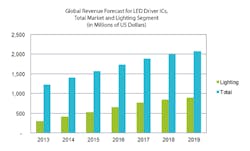A new report from industry analyst IHS illustrates the growing importance of illumination in the LED market, as LED driver revenue from lighting applications rose to $305 million in 2013. That figure represents 25% of the $1.2 billion driver market, IHS said, predicting an increase to $893 million in the next five years (see the figure).
“Lighting represents the fastest-growing segment of the LED market and is accounting for a larger share of market revenue, as well as of overall driver sales,” according to Jamie Fox, principal LED analyst for IHS, citing the company’s new report, “LED Driver ICs—World.”
Lamps and luminaries make up the bulk of the lighting market, with flashlights, architectural illumination, and other applications representing a smaller share, IHS said. Lamps accounted for most of the lighting units shipped last year and for 50% of the revenue for all lighting ICs.
LED drivers are ICs that manage and control the electrical current for an LED. They play a key role in energy savings and are used to support most high-brightness LEDs, according to the IHS report. Other key markets for driver ICs include signs, mobile handsets, televisions, notebook computers, monitors and tablets, and automotive applications. Though gains are expected in the overall LED market, suppliers serving the lighting market are expected to see the greatest increases in LED driver IC sales in the next few years.
In a separate report, IHS points to the growing market for LED technology in China, as one of the country’s manufacturers recently entered the top ranks of LED suppliers worldwide. In 2013, MLS Electronics Co. Ltd. rose to number 10 in the worldwide market for packaged LEDs, up from fourteenth place in 2012, according to IHS. The other top 10 players are based in South Korea, Japan, the United States, Germany, and Taiwan (see the table).
“Since 2011, most of the new LED production capacity that has been added worldwide has occurred in China,” Fox said. “Because of this, it was inevitable that Chinese companies eventually would penetrate the ranks of the top 10 LED suppliers. MLS was first to join the global elite, having established itself as the clear leader in the Chinese market by capitalizing on strong domestic demand. For the major suppliers, MLS’s ascent into the market’s upper ranks represents a clear signal that Chinese firms soon will become major competitors in the global LED business.”
The report also points to China’s large and fragmented LED supply base, noting that MLS’s sales accounted for less than 10% of Chinese LED revenue in 2013, despite leading the domestic market in sales. Local Chinese suppliers compete mainly among themselves for the large and growing domestic LED market, primarily because extremely low prices in China make the market inaccessible to many foreign competitors. But IHS expects Chinese companies to play a larger and more global role over time.
“IHS expects the LED revenues of Chinese vendors to grow steadily over time, as the country’s economy continues to grow strongly,” the company said. “Because of this, Chinese LED suppliers will begin to sell more internationally and come into competition with foreign rivals.”
The global market for LED driver ICs will top $2.0 billion by 2019, with lighting accounting for nearly $1.0 billion of that total. (courtesy of IHS Technology, June 2014)









